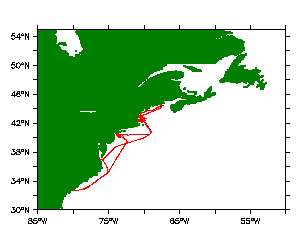Size Distribution Data for: NEAQS 2002
|
|
-
VESSEL: R/V RONALD H. BROWN
-
DEPARTED: Charleston, South Carolina on 12 July, 2002
-
ARRIVED: Portsmouth, New Hampshire on 26 July 2002
-
DEPARTED: Portsmouth, New Hampshire on 29 July 2002
-
ARRIVED: Charleston, South Carolina on 11 August 2002
-
Link to more NEAQS 2002
pages
|
 |
11-February-2003
PLEASE NOTE: These data are subject to revision and, thus, are
passsword protected. If you wish to have the data please contact Jim
Johnson or
Timothy Bates for
a password.
-
The first data sets include particle number-size distributions in the diameter
range of 0.003 to 0.6 micrometers Stokes diameter made with an ultrafine
DMPS (to 20 nm) and a DMPS (20 to 600nm). All measurements were made at a
relative humidity of 55%. The data have been separated into legs 1 and 2. Additionally, the
data are offered as filtered or unfiltered. The unfiltered data include all size
size distributions (excluding periods of calibration). The filtered distributions
show only those distributions where the total CN concentrations were stable over the
course of each measurement.
files: NEAQS2002_nsd_dmps_leg1.csv NEAQS2002_nsd_dmps_leg2.csv NEAQS2002_nsd_dmps_leg1_filter.csv NEAQS2002_nsd_dmps_leg2_filter.csv
-
The second data sets include particle number-size distributions in the diameter
range of 0.5 to 20 micrometers aerodynamic diameter. The APS diameters
are aerodynamic and have not been corrected to Stokes diameter via calculation
or estimates of particle density. The APS data larger than 10 micrometers
are not useful due to significant particle losses in the inlets including
the ship's sampling mast, distribution tubing and APS inlet. All measurements
were made at a relative humidity of 55%. The APS data are given in the same types of files
described above (legs 1 and 2, unfiltered and filtered).
file: NEAQS2002_nsd_aps_leg1.csv NEAQS2002_nsd_aps_leg2.csv NEAQS2002_nsd_aps_leg1_filter.csv NEAQS2002_nsd_aps_leg2_filter.csv
-
The third data sets include particle number-size distributions in the diameter range
of 0.003 to 10 micrometers Stokes diameter. The distributions are a combination
of DMPS and APS data where the APS data have been converted to Stokes diameters.
This conversion was done using densities calculated from measured chemistry. The diameter
channels in the overlap region were chosen in the following manner: the last 2 DMPS
channels were discarded and, after converting to Stokes diameters, the first APS
diameter channel that was larger than the last valid DMPS channel was chosen as the first
APS channel. Each combined distribution was regridded onto a common set of diameters.
All measurements were made at a relative humidity of 55%. The files
that have ambientRH in the filename contain distributions shifted to represent ambient conditions.
The diameters were shifted using growth factors calculated from measured chemistry at the ambient
temperature and RH. The growth factors were applied to the distributions at 55% RH and then
regridded onto a common set of diameters. The DMPS/APS data are given in the same types of
files described above (legs 1 and 2, unfiltered and filtered).
file: NEAQS2002_nsd_dmps_aps_leg1.csv NEAQS2002_nsd_dmps_aps_leg2.csv NEAQS2002_nsd_dmps_aps_leg1_filter.csv NEAQS2002_nsd_dmps_aps_leg2_filter.csv NEAQS2002_nsd_dmps_aps_ambientRH_leg1.csv NEAQS2002_nsd_dmps_aps_ambientRH_leg2.csv
More information about these data can be found by clicking on the blue
"Instrument Information" tab above.
The following files are available for downloading. Please note: one data
file may cover more than one time period, thus,some files may be listed
more than once. All files are in csv (comma separated value) format.
After several lines of general information each file starts with a first
row that contains the particle diameter in microns for that column.
The first column contains the date/time in Day-of-Year, DOY. DOY 32.5 is
1200 noon UTC on 1-February. All data are in units of dN/dlog10(Dp), N/cm^3.
Missing data are designated by a -99 or a -999.
Select Data Set for Download
U.S.Dept of Commerce /
NOAA /
OAR /
PMEL /
Atmospheric Chemistry

